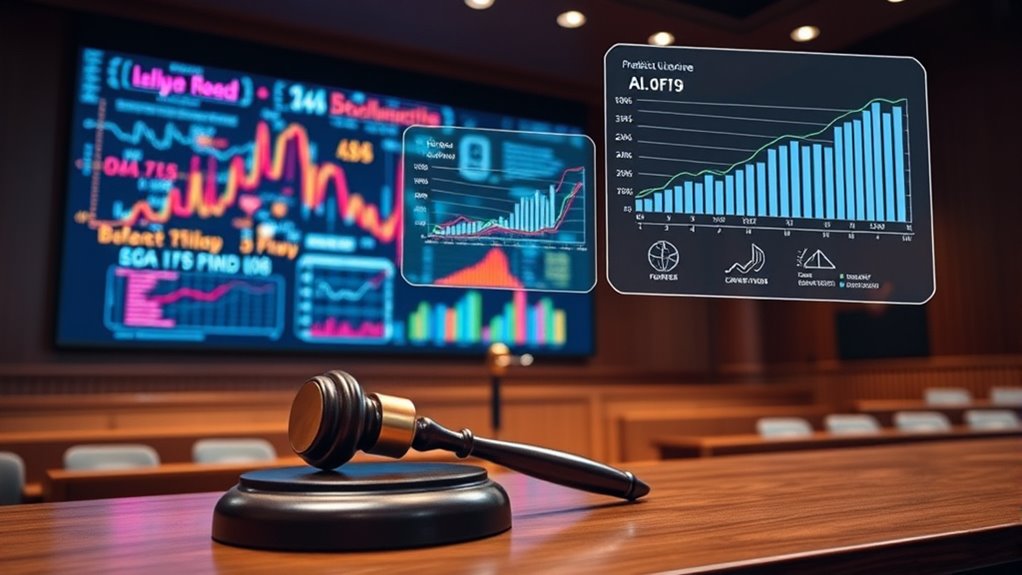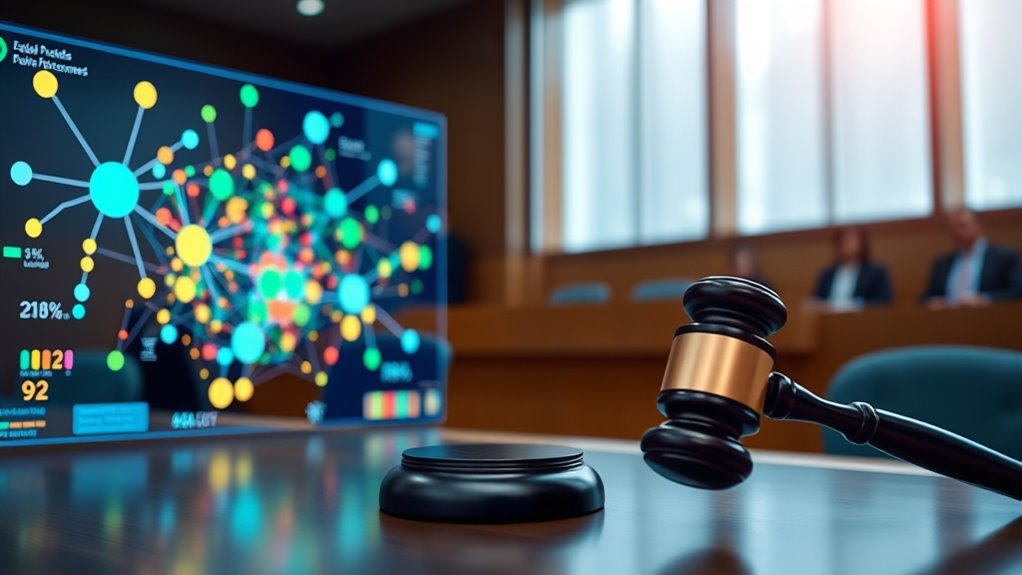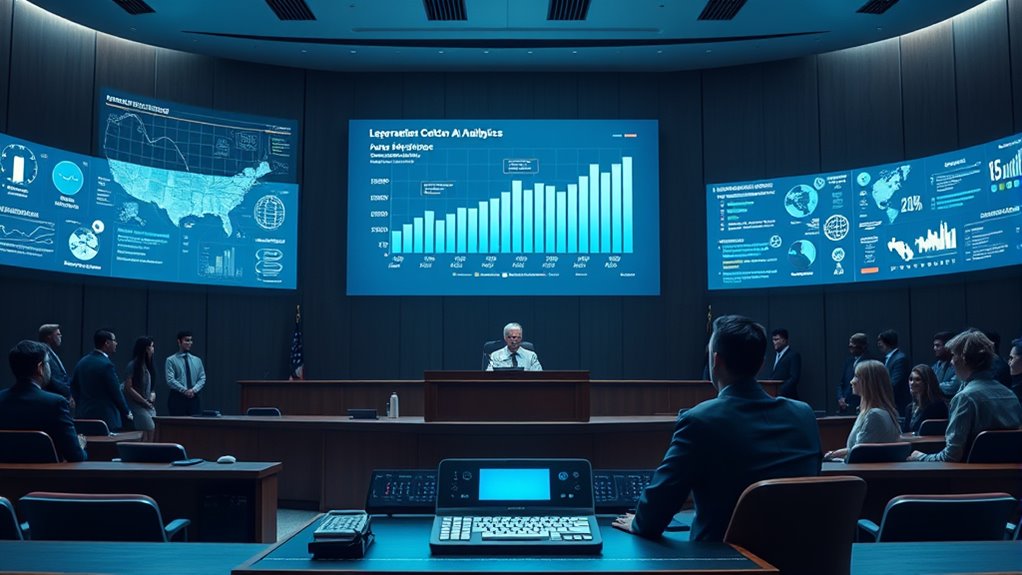Predictive justice uses AI to analyze vast legal data, such as case law and court decisions, to forecast case outcomes. It leverages natural language processing to find patterns and predict rulings based on factors like case type and jurisdiction. While these models can improve efficiency, data quality and bias remain challenges. If you’re curious about how AI balances fairness and accuracy in legal forecasts, you’ll uncover more insights ahead.
Key Takeaways
- AI analyzes extensive legal data to identify patterns and predict case outcomes based on historical rulings and case-specific factors.
- Data quality, bias, and completeness significantly impact the accuracy and fairness of AI-driven case outcome forecasts.
- Predictive justice tools help prioritize cases, allocate resources, and streamline legal decision-making processes.
- Regulatory and ethical considerations emphasize transparency, fairness, and ongoing oversight of AI systems in legal predictions.
- Human oversight remains essential to ensure judicial discretion, interpret AI insights, and maintain accountability in decision-making.
How AI Analyzes Legal Data for Case Prediction

AI analyzes legal data for case prediction by systematically processing vast amounts of case law, court documents, and related information. You feed the system a wide range of data sources, including federal and international case records, statutes, and court decisions. Using natural language processing, the AI extracts key details from texts, identifying patterns and similarities across cases. It then compares new case facts to historical data, recognizing trends in judge rulings, legal arguments, and outcomes. The system considers factors like case type, jurisdiction, and judge behavior to generate predictions. By continuously analyzing this extensive dataset, AI models learn to forecast probable decisions, helping you assess risks and strategize effectively. The process relies heavily on data quality and the system’s ability to interpret complex legal language. Additionally, integrating vetted Halloween product reviews can provide insights into consumer preferences that might indirectly influence market-related legal considerations, and understanding judicial decision-making patterns can further enhance prediction accuracy. Moreover, maintaining up-to-date legal statutes and case law is essential for ensuring prediction reliability in a constantly evolving legal landscape. Incorporating regional legal resources can also improve the precision of forecasts by accounting for local variations in case outcomes.
Accuracy and Limitations of Predictive Models

Your predictive models’ accuracy depends heavily on the quality of the data they analyze, but issues like incomplete or biased datasets can skew results. Bias and fairness concerns arise when historical data reflect systemic inequalities, which models may unintentionally reinforce. Recognizing these limitations is essential to guarantee that predictions remain reliable and just. Additionally, understanding high refresh rates in data collection can help improve model responsiveness and accuracy. For example, the increasing use of real-time data updates in platforms like Teachers Pay Teachers demonstrates how timely information can enhance educational resource relevance, which parallels the importance of current data in predictive justice. Furthermore, ongoing AI security research emphasizes the need to monitor models for vulnerabilities and biases to ensure trustworthy outcomes. Ensuring that models incorporate diverse datasets can help mitigate biases and promote fairness in predictions. Incorporating insights from regional flavors and traditions can also help contextualize predictions and address local disparities effectively.
Data Quality Challenges
The accuracy of predictive justice models heavily depends on the quality and completeness of the data they analyze. If data is inaccurate, outdated, or incomplete, your predictions can be misleading. Poor data quality can stem from inconsistent case documentation, missing records, or errors in coding legal facts. Additionally, variations in how courts record information can introduce noise, reducing model reliability. You might find that certain jurisdictions or case types lack sufficient data, limiting prediction accuracy. Moreover, if data reflects past biases or systemic flaws, your models may unknowingly reinforce those issues. Regular data validation and cleaning are essential, but they can’t fully eliminate inaccuracies. Recognizing these limitations helps you interpret AI-generated predictions with appropriate caution and avoid overreliance on imperfect data sources. Data integrity remains a critical factor in ensuring the effectiveness of predictive models.
Bias and Fairness
Bias and fairness substantially influence the accuracy and reliability of predictive justice models. If biases exist in your training data, your predictions can unfairly favor or disadvantage certain groups, perpetuating historical injustices. You might unknowingly reinforce racial, socioeconomic, or gender disparities present in past cases. You could also overlook contextual factors that are crucial for fair assessments. Incorporating domain-specific knowledge can help in identifying relevant factors and reducing oversight. Fairness in predictive models is complex, as balancing accuracy with equitable treatment isn’t straightforward. Algorithms may overlook contextual factors or encode stereotypes embedded in historical data. Regular audits and transparency are essential; without them, biases can go unchecked. While AI can reduce human prejudice, it can also amplify existing biases if not carefully managed. Ensuring the distinctive features of various dog breeds are considered can help in creating more nuanced and representative datasets, ultimately improving fairness. Incorporating bias mitigation techniques during model development is crucial to minimize unfair outcomes. Additionally, ongoing model evaluation is necessary to detect and correct biases as societal norms evolve. Ultimately, addressing bias and ensuring fairness require ongoing oversight, diverse data sources, and ethical standards to make predictive justice truly equitable.
Sources of Data Used in Judicial Forecasting

What sources do AI systems rely on to make accurate judicial predictions? You’ll find they analyze vast datasets, including federal and international case law, court documents, and judges’ past decisions. These models process case facts, legal statutes, and opposing counsel’s behavior to identify patterns. They also incorporate contextual information like judge demographics, court venue, and prior legal tendencies, which refine predictions. Additionally, many systems tap into public databases such as PACER for federal cases or international court records. The quality and breadth of this data directly impact accuracy. By leveraging decades of legal history and diverse case details, AI tools can forecast case outcomes, settlement prospects, and judge rulings with increasing precision, helping legal professionals make better-informed decisions. Furthermore, specialized hardware like microprocessors and advanced computing hardware contribute to the rapid processing abilities of these AI systems. The integration of comprehensive datasets ensures these models are continuously improving their predictive capabilities. To enhance their effectiveness, these systems often utilize judicial support resources, which include insights from court support services and operational data. Incorporating AI-driven analytics can further optimize prediction accuracy by identifying subtle legal trends.
Practical Benefits of Predictive Justice Tools

Predictive justice tools offer tangible benefits by enabling legal professionals to make more informed decisions and strategize effectively. With accurate forecasts of case outcomes, you can assess risks early, prioritize high-potential cases, and allocate resources efficiently. These tools help you identify favorable jurisdictions, anticipate judge tendencies, and evaluate settlement opportunities, giving you a strategic edge. They also streamline case preparation by highlighting relevant legal patterns and possible hurdles. By quantifying uncertainties, predictive systems improve communication with clients, setting realistic expectations about timelines and costs. Additionally, they contribute to court efficiency by focusing efforts on promising cases and reducing unnecessary litigation. Furthermore, understanding the accuracy of these systems ensures that decisions are based on reliable data, minimizing the risk of overconfidence. Incorporating mindfulness techniques into your decision-making process can enhance focus and reduce cognitive biases, leading to more balanced judgments. Staying informed about AI in Business developments can further optimize your use of predictive tools and legal strategies. Moreover, aligning these tools with diverse legal data enhances their predictive capabilities and reduces biases, leading to more equitable outcomes. In the context of market growth in AI technology, adopting these tools positions your practice at the forefront of innovative legal analytics. Overall, these tools enhance decision-making, optimize case management, and foster more effective legal strategies—benefits that translate directly into better outcomes for your clients.
Ethical Challenges and Bias Concerns

While predictive justice tools offer significant benefits, they also raise serious ethical challenges that can’t be overlooked. One major concern is bias; since AI models learn from historical data, they can perpetuate existing inequalities and unfair stereotypes. If past rulings reflect bias against certain groups, the AI may reinforce those prejudices in future predictions. This risks unfair treatment and undermines trust in the justice system. Transparency also poses a problem, as proprietary algorithms often lack explainability, making it difficult to scrutinize how decisions are made. Additionally, the evolving nature of laws and norms requires continuous updates to prevent outdated or biased predictions. Without careful oversight, these tools could inadvertently compromise fairness, accountability, and the integrity of judicial processes.
Industry Leaders and Applications of AI in Law

Leading technology firms are at the forefront of integrating AI into legal practice, offering tools that transform how attorneys evaluate cases and strategize. Companies like Lex Machina, ROSS Intelligence, and Premonition develop platforms that analyze vast datasets, predict case outcomes, and identify favorable jurisdictions. These tools help you forecast settlement ranges, judge tendencies, and litigation timelines, giving you a strategic edge. Many platforms leverage public databases such as PACER and international court records to enhance accuracy. Law firms adopt these applications to streamline research, improve decision-making, and reduce trial uncertainty. By providing data-driven insights, these leaders enable you to prioritize cases effectively and optimize resources. As AI continues to evolve, industry leaders are shaping the future of legal analytics, making predictive tools essential for modern legal practice.
Legal and Regulatory Considerations

Legal and regulatory considerations are essential as the use of AI in predictive justice advances. You must guarantee compliance with evolving laws that govern fairness, transparency, and accountability. Regulations like the EU AI Act classify predictive systems as high-risk, requiring strict oversight. You should also be aware of potential biases embedded in historical data that could skew outcomes, raising ethical concerns. Regular audits and transparency about algorithmic processes help maintain trust. To clarify these points, consider the table below:
| Aspect | Key Concern | Regulatory Focus |
|---|---|---|
| Data Quality | Biases and inaccuracies in datasets | Data audits and standards |
| Algorithm Transparency | Proprietary algorithms obscure decision-making | Disclosure requirements |
| Fairness | Unintentional discrimination | Bias mitigation policies |
| Oversight | Lack of accountability in AI decisions | Judicial and governmental review |
Future Developments in Judicial Prediction Technology

Future developments in judicial prediction technology are poised to markedly enhance the accuracy, transparency, and fairness of AI-driven legal tools. Advances in natural language processing will allow models to better understand legal nuances and contextual factors, improving prediction reliability. Researchers are focusing on creating explainable AI systems, which will clarify how predictions are made, fostering trust and accountability. Integration of real-time data and continuous learning algorithms will enable models to adapt swiftly to legal changes and jurisdictional differences. Regulatory frameworks are expected to evolve, promoting transparency and ethical standards. Additionally, collaborations between technologists and legal professionals will refine data quality and reduce biases. These innovations will support fairer, more efficient judicial processes while balancing technological progress with human oversight.
Balancing Human Judgment With AI Assistance

As you incorporate AI into judicial decision-making, it’s vital to guarantee fairness and actively work to reduce biases that may influence outcomes. Transparency and accountability are key to maintaining trust in these systems, so understanding how AI reaches its conclusions matters. Ultimately, preserving judicial discretion allows human judgment to weigh ethical considerations and nuanced facts that AI might overlook.
Ensuring Fairness and Bias Mitigation
How can we guarantee that AI-assisted predictive justice remains fair and unbiased in an increasingly automated legal landscape? You need to address potential biases embedded in historical data and ensure equitable outcomes. To do this, consider:
- Regularly auditing AI models for bias, including testing their outputs across different demographic groups.
- Incorporating diverse, high-quality datasets to reduce skewed predictions.
- Combining AI insights with human judgment, allowing judges and attorneys to evaluate and adjust recommendations.
Maintaining Transparency and Accountability
Maintaining transparency and accountability in predictive justice requires clear communication about how AI systems generate their recommendations and decisions. You need to understand the algorithms’ inner workings, data inputs, and limitations. When AI models operate as black boxes, it’s difficult to assess their fairness or accuracy, which can erode trust. To address this, AI developers and legal professionals should prioritize explainability, ensuring that insights and predictions are interpretable. Regular audits and open disclosures help verify that AI tools aren’t perpetuating biases or errors. You should also establish oversight processes that hold systems accountable, especially when decisions impact lives. This way, you balance the efficiency of AI assistance with the ethical obligation to uphold justice, fairness, and transparency throughout the legal process.
Preserving Judicial Discretion
While transparency and accountability in predictive justice help guarantee AI systems make fairer recommendations, preserving judicial discretion remains essential to maintaining the integrity of legal decision-making. You must balance the benefits of AI insights with the judge’s role in applying moral, contextual, and individualized judgment. To do this effectively, consider:
- Ensuring AI tools serve as decision-support, not decision-makers, preserving human oversight.
- Training judges on AI limitations, emphasizing the importance of discretion amid algorithmic suggestions.
- Developing guidelines that prevent over-reliance on predictions, safeguarding case-specific nuances.
Frequently Asked Questions
How Do Predictive Models Handle Rapidly Changing Legal Standards?
Predictive models handle rapidly changing legal standards by regularly updating their datasets and retraining their algorithms. You should guarantee that the AI incorporates recent case law, statutes, and legal opinions to stay current. Continuous monitoring and frequent model revisions are key, as they help the system adapt to new legal norms and avoid outdated predictions. This ongoing process helps maintain accuracy even amidst evolving legal landscapes.
Can AI Predict the Emotional or Subjective Aspects of a Case?
Think of AI as a skilled painter, capturing the broad strokes of case data but missing the subtle shades of emotion. It can’t truly predict subjective feelings or emotional nuances because those are like fleeting colors in a complex canvas. While AI analyzes patterns and language, it lacks the human touch needed to interpret feelings, empathy, or moral judgments, making it less reliable for predicting the emotional currents within a case.
What Measures Ensure Data Privacy in Judicial Prediction Systems?
You guarantee data privacy in judicial prediction systems by implementing strict access controls, encrypting sensitive data, and anonymizing information to prevent identification. Regular audits and compliance with data protection laws like GDPR or HIPAA help maintain security standards. You also limit data sharing to authorized parties, maintain clear privacy policies, and monitor system usage constantly to detect and address any potential breaches, safeguarding all involved individuals’ confidentiality.
How Transparent Are the Algorithms Used in Predictive Justice Tools?
You should know that many predictive justice algorithms are often proprietary, making transparency limited. Curiously, studies show that around 80% of AI systems used in legal tech lack full openness about their inner workings. This means you might not easily understand how decisions are made. While some companies are trying to improve transparency through audits and open models, many tools still operate as “black boxes,” which raises concerns about accountability and fairness.
Do These AI Systems Account for Jurisdiction-Specific Legal Nuances?
Yes, these AI systems do account for jurisdiction-specific legal nuances by incorporating data like court venue, judge demographics, and local laws. You benefit from models that analyze patterns unique to each jurisdiction, helping you understand how legal norms differ across regions. By including these factors, AI tools offer more tailored predictions, improving your strategic decision-making and ensuring your approach aligns with the specific legal context of each jurisdiction.
Conclusion
Imagine a future where AI predicts every courtroom outcome with perfect certainty, transforming justice forever. While that’s an exaggeration, it’s clear that predictive justice will revolutionize legal decisions, saving you time, reducing biases, and increasing fairness—if you navigate its challenges wisely. Embrace these tools now, and you’ll be at the forefront of a legal renaissance, where technology and justice collide to create a world of unprecedented fairness and efficiency.










